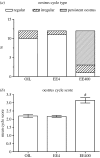Altered reproductive success in rat pairs after environmental-like exposure to xenoestrogen
- PMID: 17456458
- PMCID: PMC2169273
- DOI: 10.1098/rspb.2007.0064
Altered reproductive success in rat pairs after environmental-like exposure to xenoestrogen
Abstract
Endocrine-disrupting compounds (EDCs) have the capacity of altering the normal function of the endocrine system. EDCs have shown dramatic effects on the reproductive biology of aquatic wildlife and may affect human reproduction as well. Studies on EDCs in mammalian species have often investigated the effects of short-term, high doses on male and female reproductive physiology. However, it is difficult to predict from such studies the effects of EDC on populations that are exposed to very low doses throughout their life via contaminated food and water. We studied the effects of EDC on mammalian reproduction with an environmental-like protocol where the endpoint is the reproductive success of exposed pairs. We focused on a subclass of EDC, the xenoestrogens, which mimic the action of natural oestrogen hormones. Male and female rats were exposed to low doses of the pure oestrogen, ethynyloestradiol, during development, by oral administration to their mothers during pregnancy and lactation, and to them until puberty. We evaluated the effects of the exposure on development and reproductive physiology of individuals, and on fertility and fecundity of pairs in which both members had been exposed to the same treatment. We found that low doses caused major reproductive deficits in the experimental animals. Very low, environmentally relevant doses did not have evident effects on exposed animals; however, the fecundity of exposed pairs was substantially altered. Environmentally relevant doses of xenoestrogens which have no evident physiological effects can alter the reproductive success of exposed pairs in natural populations.
Figures




References
-
- Anway M.D, Cupp A.S, Uzumcu M, Skinner M.K. Epigenetic transgenerational actions of endocrine disruptors and mate fertility. Science. 2005;308:1466–1469. doi:10.1126/science.1108190 - DOI - PMC - PubMed
-
- Bogh I.B, Christensen P, Dantzer V, Groot M, Thofner I.C.N, Rasmussen R.K, Schmidt M, Greve T. Endocrine disrupting compounds: effect of octylphenol on reproduction over three generations. Theriogenology. 2001;55:131–150. - PubMed
-
- Brown R.P, Greer R.D, Mihaich E.M, Guiney P.D. A critical review of the scientific literature on potential endocrine-mediated effects in fish and wildlife. Ecotoxicol. Environ. Saf. 2001;49:17–25. doi:10.1006/eesa.2000.2015 - DOI - PubMed
-
- Brown A.R, Riddle A.M, Winfield I.J, Fletcher J.M, James J.B. Predicting the effects of endocrine disrupting chemicals on healthy and disease impacted populations of perch (Perca fluviatilis) Ecol. Modell. 2005;189:377–395. doi:10.1016/j.ecolmodel.2005.03.009 - DOI
Publication types
MeSH terms
Substances
LinkOut - more resources
Full Text Sources
